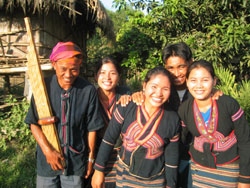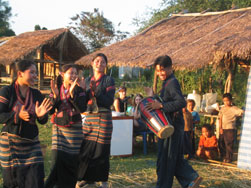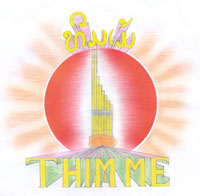| Background | |
| Hmong | |
| Khmu | |
| Yao | |
| Lahu | |
| Akha | |
| Stories | |
| Schedule | |
| Sponsorship | |
| Contact | |
| 'Team Mee' (Khmu) - The New Generation Team | ||
The Khmu theatre team lives Houei
Sai Noi village in the Nampuk area of Bokeo province, on the crossroads
which lead in one direction to Houei Sai town and in the other to
Paktha and Pa Oudom districts. |
||
 |
 |
|
The team members like most of the other villagers moved there around 10 years ago from the hills of Oudomxay, Nalee district of Luang Namtha or from Pa Oudom in Bokeo province. They came  in
search of an easier life than they had in the hills, better access
to health and other services, and some paddy rice land. Some who arrived
first, have achieved their goal and now also have access to the irrigation
system, which means they can also plant rice and other crops in the
dry season, giving them enough food to eat all the year round. Others
have only a small piece of upland field. in
search of an easier life than they had in the hills, better access
to health and other services, and some paddy rice land. Some who arrived
first, have achieved their goal and now also have access to the irrigation
system, which means they can also plant rice and other crops in the
dry season, giving them enough food to eat all the year round. Others
have only a small piece of upland field. To date, the Khmu village theatre team has created and performed plays for drug and HIV/AIDS prevention and on generating income through cash crops. They usually speak Khmu, but are also fluent in Laolum, and sometimes perform in this language. |
||
| Khmu history and culture | ||
| There are around 500,000 Khmu living
in Laos, mostly in the Northern provinces. They belong to the Mon-Khmer
language family. They are also known in Laos as Lao Theung, which
means the people who inhabit the mountain slopes; as compared to the
Lao of the lowlands (Laolum) or of the mountain tops (Lao Soung).
The Khmu live in houses with woven bamboo walls, and built on stilts. A Khmu village can also be recognised by the rice store outside the village, which should ensure that in the case of a fire in the village, at least the people at least have rice to eat. The Khmu are animists. When they are sick, they go to see the spirit doctor in their village who gives advice on ways of appeasing the spirits and healing the illness. This sometimes involves sacrificing a chicken or even a buffalo, if the illness is a serious one. When they have celebrations, they drink sweet rice wine called Lao Hai from a jar through long grasses, a pleasant communal experience. In January, they have a festival for 3 nights and 3 days to celebrate the rice harvest and every village family contributes one jar of Lao Hai. Then they sing 'Teum', Khmu songs with a melodius swinging rhythm which inspires people to dance. |
||